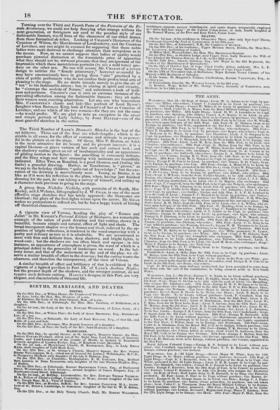Turning over the Third and Fourth Parts of the Portraits
of the Fe- male Aristocracy, we could not help fancying what strange notions the next generation, or foreigners not used to the peculiar style of our fashionable limners, world form of the characters of our titled dames, from these fantastical sketches. Looking at CHALON'S likenesses of the Countess of Wilton, the Marchioness of Londonderry, and the Countess of Lovelace, any one might be excused for supposing that these noble ladies were more desirous to challenge attention than scrupulous as to the means. Now, as we cannot suppose that ladies of quality would purchase pictorial distinction at the formidable price of appearing what they should not be, weniust presume that they are ignorant of the impression which these meretricious portraits (to use a mild term) pro- duce on the other sex. No one will accuse Mr. CR.t.tost of a covert design to satirize the " female aristocracy," however successful he may have unconsciously been in giving them " airs " practised by a class of public performers who do not confine their profestional arts of pleasing to the stage. Ile no doubt intends merely to give the air of " ton" to his fashionable sitters ; but, in aiming at spirit and vivacity, he " o'ersteps the modesty of Nature," and substitutes a look of bold- ness and pertness. CHALON'S case is only an extreme instance of the prevailing affectation among the fashionable homers; they all make their women seem courting admiration. Let any one who remembers Mrs. CARPENTER'S chaste and lady-like portrait of Lord Byron's daughter when Baroness King, look at CHALON'S of her as Countess of Lovelace, and see which of the two women—for they are not the same —he would prefer. We are glad to note an exception in the sweet and simple portrait of Lady Ashley, by Jon:: Havrtat—one of the most graceful sketches in the series.































 Previous page
Previous page